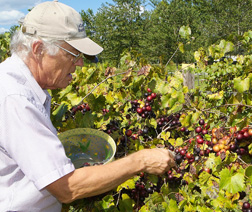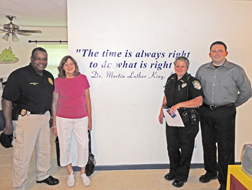The native variety is both sweet and juicy
 In his retirement, Don Loftus spends much of his time tending to his vineyard, in which he grow the Ison, Supreme and Delicious varieties of muscadine grapes.
In his retirement, Don Loftus spends much of his time tending to his vineyard, in which he grow the Ison, Supreme and Delicious varieties of muscadine grapes.
ALACHUA – It’s that time of year again when the dark purple and golden grapes of Florida are ripe for the picking, just in time to bring a refreshing quencher to the dog days of summer. For a few short weeks each year, Florida’s native muscadine grapes adorn vines in the wild and in area farms and vineyards.
At the Loftus Family Farm in Alachua, the grape picking season officially opened Saturday, Aug. 11. Other area u-pick grape operations are also underway as the fruits ripen.
Weather, as unpredictable as it is, has a significant impact on the health of grape vines and on how long it takes their fruit to ripen.
Unlike last year’s scorching temperatures, which accelerated the ripening process, this year’s crop is right on schedule says Don Loftus, a local farmer and viticulturist.
“The Supreme grape seems to be coming on strong right now,” he said.
Perhaps mastering the technique of cultivating the grapes is knowing when they’re just right for picking.
“The biggest problem is picking the Supremes too early,” Loftus explained. As much as those plump purple grapes call out to be picked, they’re probably not ready yet. “You want to wait until they’re really dark,” he said.
Unlike other fruits, muscadine grapes do not ripen significantly once picked.
And as the weather goes, winters can be most damaging to the grape vines, but not this year. Loftus said his plants survived the mild winter and are on track for a sizable yield this year.
“Our production is up and we expect to have a good solid production of somewhere around 7,000 pounds this year, but it’s hard to estimate” said Loftus.
With recent heavy rains, Loftus said he’s noticed that the grapes get even plumper than usual and to prevent breaking, there’s a technique for picking them – a technique he said he’s happy to demonstrate when customers visit his vineyard.
Loftus got into the business of growing muscadine grapes about seven years ago when he started planning for his retirement. Since retiring from the University of Florida two summers ago, he has dedicated his time to the Loftus Family Farm, which includes the muscadine grape vineyard he has developed and grown from scratch. Well into the throws of retirement, Loftus now realizes he left one full-time job for another, operating a vineyard and farm.
In 2004, Loftus first started converting the field that once grew persimmons, which were also negatively affected by North Florida’s winter weather patterns, into 1.5 acres of grapes.
The u-pick farm is one of a handful in the area and is open to the public. The Loftus Family Farm specializes in the Ison and Supreme varieties of muscadine grapes, but is branching out into others as well.
Last year, Loftus began adding a new variety, the Delicious, a self-pollinating muscadine developed by the University of Florida. He’s using the new variety to replace the Supremes lost to natural causes and winter damage in prior years. It will take a few years before the Delicious will be on a scale ready for picking, but this year, they’re already producing fruit. Loftus compares the fruit to the Supremes, joking, “As their names suggests, they really are quite delicious and they have the same crunch and taste to them.”
The ‘Delicious’ variety is also disease resistant and is among the top yielding muscadines.
Loftus said he plans to eventually expand the vineyard by another half-acre, probably including golden muscadine varieties. Loftus has his hands full meticulously attending to the 14 rows of grape vines, each several hundred feet long and none of which are sprayed with potentially dangerous chemicals and pesticides.
Indigenous to the southeast region of North America, muscadine grapes ripen in late summer. Right about now seems to be a good time to pick grapes at the Loftus Family Farm where avid pickers will be welcomed to their hands-on picking experience. Meanwhile, Loftus says thousands of pounds of the juicy dark purple and black grapes await eager pickers.
The vineyard has already become a popular spot among many people who are aware of the u-pick farm. Loftus credits some of that success to the well-manicured rows of grapes and relaxing atmosphere at his family’s farm. Loftus said many pickers like to eat the grapes as they are, some use them for producing wine and others for making jelly and sauces and freezing for later consumption. Florida’s $20 million-a-year grape industry is typically the second- or third-largest market for table grapes and wine in the country.
The Loftus Family Farm keeps it simple again this year, charging an even $1 per pound of grapes.
The address for the vineyard is 15585 NW 29 Street, Gainesville. East of Alachua on NW 156th Avenue, the farm is at the midway point between State Road 121 and County Road 231.
Generally open from mid-August to early October, pickers are welcome on Saturdays from 9 a.m. until 6 p.m. and on Sundays from 1 until 6 p.m. Appointments are also available Monday through Friday for anyone wishing to arrange a picking party.
Additional photos, health benefits, directions to the vineyard and uses for muscadine grapes and other information are available at LoftusFamilyFarm.com
# # #
E-mail editor@alachuatoday.com



